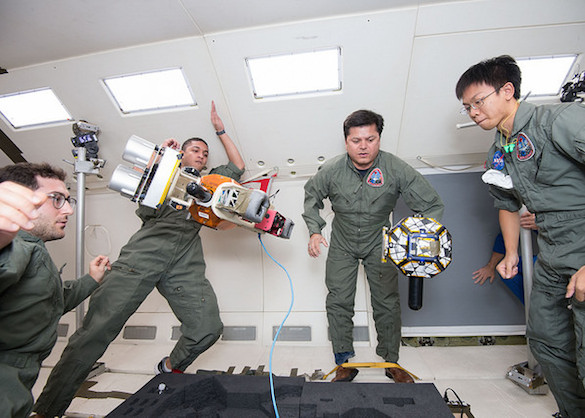Reduced Gravity Flight Demonstration of Synchronized Position Hold Engage Reorient Experimental Satellites (SPHERES) Integrated Navigation Sensor Platform for EVA [Extra-Vehicular Activities] Control
PI: Alvar Saenz Otero, Massachusetts Institute of Technology
PI: Alvar Saenz Otero, Massachusetts Institute of Technology

- TA04 Robotics, Tele-Robotics and Autonomous Systems
Since 2006, the Synchronized Position Hold Engage Reorient Experimental Satellites (SPHERES) have been a mainstay of autonomous, robotic control testing aboard the International Space Station (ISS). The SPHERES satellites operate within the confines of the ISS, relying on the benign, supervised, and pressurized environment to function. Further research into new technologies is required to develop the capabilities required for extravehicular activities (EVA) with a future generation of SPHERES satellites. In particular, new sensors and actuators are required that can operate in the space environment.
To maximize ISS test session productivity and minimize unnecessary use of consumables and crew time aboard ISS, we propose the use of two parabolic flight weeks to conduct preliminary testing of the INSPECT system. Parabolic testing will allow for the characterization of system inertia properties, thruster plume impingement, and control law stability. These campaigns will be highly useful as a means of bridging the ongoing 2D testing with future, long duration microgravity 3D testing.
Additionally, any major control implementation issues can be addressed between flights to maximize the utility of the parabolic campaigns. These solutions can then be applied to the ISS system to prevent similar issues and loss of ISS time. This process has extensive heritage, since both the RINGS (Resonant Inductive Near- field Generation System) and SPHERES satellites themselves underwent the same cycle of ground, parabolic flight, and ISS testing to develop the on-orbit SPHERES facility.
Technology Details
-
Selection DateAFO8 (Apr 2014)
-
Program StatusCompleted
- 2 Parabolic
Development Team
-
PIAlvar Saenz Otero
-
Organization
-
Sponsor
-
More Information

